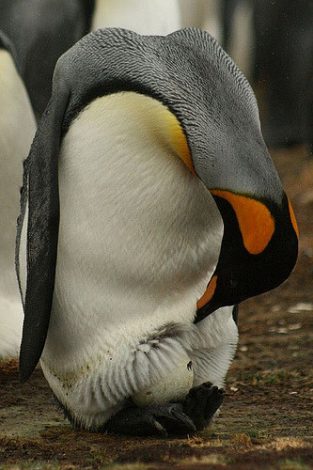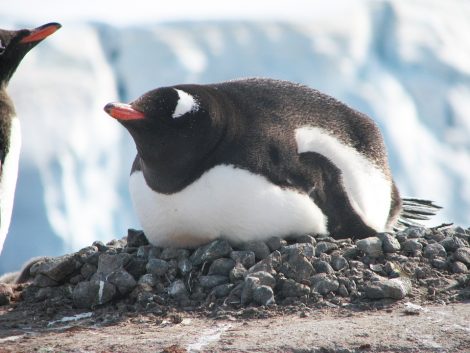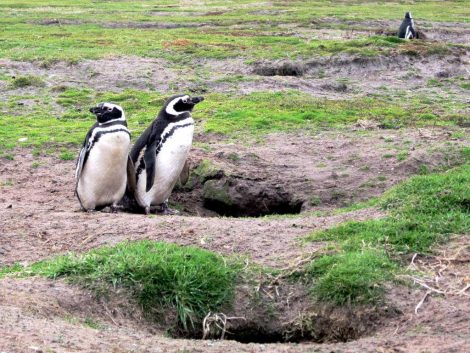Yes, penguins do have nests. All the 17 species of penguins have nests; some on bare ice or some build nest using stones or stay in guanos. Species like Emperor and King Penguin don’t build any nest as such; they breed and lay eggs on open land.
The type of nests that the penguins make depends on the surrounding and the type of region they live. As any other birds, nest building is the crucial and significant part of the penguin’s action. Penguins use their nest mainly for breeding.
Most commonly penguins breed in Antarctic summer, and few species do mate in winter. Even though penguins are not birds, they have common behaviors of birds. Especially the mating behavior of birds and penguins are similar.
The nests may be of stone, rocks, pebbles, soft materials collected from the surrounding or a simple burrow. Sometimes, penguin-like Gentoo that lives in the true Antarctic region can also use the poop to melt the ice and breed on the rocky surface.
Occasionally, penguin-like Adelie penguin, which also lives in the icy Antarctic, will scoop up the ice to find the less icy surface to lay eggs and raise the chicks.
Nest of Emperor Penguin:
Emperor penguins are the largest of all living penguins and the most magnificent penguin species. They live in frigid and harsh Antarctic. Even though Emperor penguins live on icy land; they stay on the ice during mating and breeding.
There is a brood patch under the Emperor penguin, covered by small plumages and a bare skin area which gives instant heat to the egg and chicks in the Antarctic. The brood patch helps the penguins while incubating the eggs and chicks.
The Reason Why No Nest:
Since Emperor penguins are endemic to Antarctic regions; they cannot go beyond the icy areas to find the nest or shelter. They have to live in the harsh cold.
Since there is no proper vegetation in the region and cannot find materials for nesting; the Emperor penguins follow the ritual of staying in the cold land throughout their lifetime.
Emperor penguins are by nature built to sustain the ice. Their blubber layer around the body helps them stay warm during winter; otherwise, Emperor penguin cannot stay in the freezing Antarctic.
Apart from the help of the blubber layer, Emperor penguin’s waterproof plumages also help them stay dry and avoid the cold wind touching the skin of the body.
Nest of King Penguin:
King Penguins also share the same nesting behavior of Emperor penguins. King penguins are the second largest living penguin species after Emperor penguins. King penguins live in the Sub-Antarctic region and do not have a nest.
They lay eggs on the dry land and incubate the eggs in the same place where they mate. The brood patch under the skin fold helps in incubating the chicks and rearing the chicks.
The Reason Why No Nest:
King Penguins do not need more heat like Emperor penguins that live in the true Antarctic region. Since the place where the King Penguins are endemic is dry, it is suitable for the King penguins to live without a nest.
The blubber in the body and the waterproof plumages are sufficient to do the need for the King Penguins in the sub-Antarctic provinces.
Adelie and Gentoo Penguins Nest:
Adelie, Gentoo and Chinstrap penguins are species that build the nest using rocks, stones, and pebbles. They collect the stones and build a nest before mating and breeding.
These penguins also find and pick soft materials like twigs, leaves, and materials that are found in the area to impress the females to get attracted for mating.
There is even fight, and aggression found while collecting the stones for nesting. The penguins steal the stones from the neighboring nest to include in the nest. The bigger and comfortable the nest is, the larger the chance of females to mate with the chosen males.
The Reason Why Penguins Build the Nest Using Stones:
Adelie, Gentoo, and Chinstrap build the nest using stones and pebbles to avoid a great loss of heat. When the stone nest is built higher, the chicks can be safe from less use of body heat. During rain, the water can pass through the stones without stressing out the chicks and eggs.
Crested penguins occupied the holes in rocks and established it as its nest.
African Penguins and Nest:
African penguins build burrows in the sand or soil. They dig the sand to make burrows or stay in the one which naturally seems like a nest.
Reason:
African penguins live in a tropical area, and they are the habitat of only South Africa and not anywhere else. They stay cool and also get warm enough from the sand where they mate and breed.
By the way, they can protect the chicks and the eggs from the land predators.
Magellanic penguins also stay in burrows that are naturally available in the area, or they dig burrows to stay warm and avoid encountering land predators.
Rockhopper Penguins and Nest:
Rockhopper penguins make burrows and nest on guanos or under vegetation to stay warm.
Reason:
The reason why Rockhopper builds burrows in guanos is that the guanos are naturally warm and it protects the penguins from releasing excess heat.
They stay under vegetation to avoid hot sun and maintain the appropriate temperature.
Conclusion:
If the nest is destroyed some penguins place their eggs on a hilltop or uncluttered beach area until they find the place and materials for nesting. The dark color poop of Gentoo penguins, absorb the mild heat of the sun faster and make the frosty surface melt to form a small nesting area.
The behavior of pooping and nesting is common while protecting the chicks from severe cold. The nest of the penguins is spotted by at least one of their partners before they forget and end up in dispute.
Penguins are very aggressive in protecting their nests and the chicks. They have dedicated parents, and few species of penguins mate with the same partner for life. At times when the partner changes, the nest also do change into a new one or else there will be a dispute between the new mate and the former mate.
References:
http://www.pinguins.info/Engels/Nestvorming_eng.html
http://penguins.neaq.org/2014/08/breeding-best-nest.html
https://www.nytimes.com/2017/03/20/science/even-penguins-have-children-who-wont-leave-the-nest.html
https://www.livescience.com/50709-penguins-use-poop-for-breeding.html


